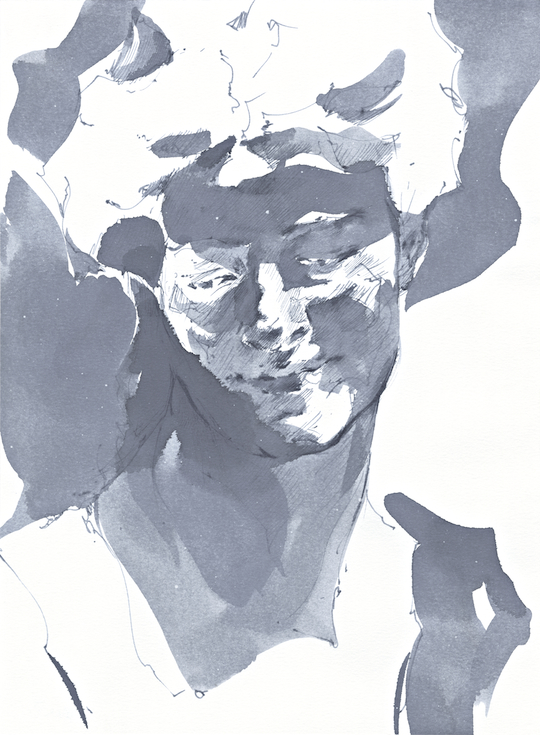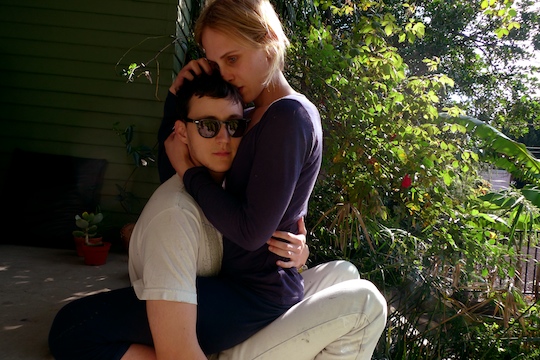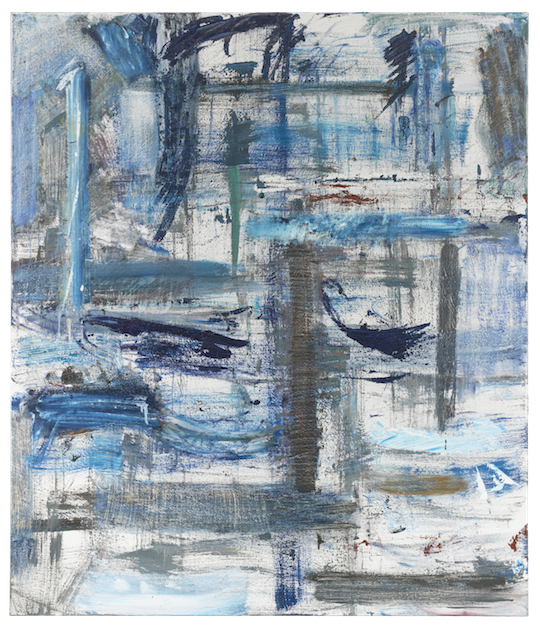The approach to the 2014 Whitney Biennial was threefold; three distinct curatorial visions converged, each curator occupying a different floor of the museum. Collective curating has long since been a tradition at the Biennial, but to have each curator overseeing an individual floor is a different approach adding another narrative focus to the exhibition at large. In addition to the narrative(s) strung together by the 103 artists selected for the Biennial, the visitor of the museum now has the additional task of building, from the ground floor up, a sense of the overall curatorial vision and the individual points of focus of all three curators.

Rebecca Morris, Untitled (#01-13), 2013. Oil on canvas, 87 x 80 in. Copyright Rebecca Morris. Courtesy of the artist and Galerie Barbara Weiss. Photographer Lee Thompson
Anthony Elms (Associate Curator at the Institute of Contemporary Art in Philadelphia) curated the second floor. In his notes to the original building design of the Whitney, architect Marcel Breuer asks “What should a museum look like, a museum in Manhattan?” Elms’ answer is that ““a museum in Manhattan should be filled with a multiplicity of voices and a sense of poetry. It should exhibit works of art from all creative disciplines and challenge the relationship between the past, the present, and histories yet to be written. Ultimately, each singular artistic statement should contain a palpable sense of the plural.”[1] Elms cultivates this plurality by including twenty-four artists and groups that, as he says, fit the following statement by poet Susan Howe: “I believed in an American aesthetic of uncertainty that could represent beauty in syllables so scarce and rushed they would appear to expand though they lay half-smothered in local history.”[2] Artists and groups represented on the floor include Academy Records and Matt Hanner, Terry Adkins, Michel Auder, Elijah Burgher, Jimmie Durham, Joseph Grigely, Susan Howe, Gary Indiana, Carol Jackson, Dave McKenzie, Rebecca Morris, My Barbarian Paul P. Public Collectors, Steve Reinke and Jessie Mott, Allan Sekula, Valerie Snobeck and Catherine Sullivan, and Charline von Heyl. Paul P.’s works have a telling softness, complementing the element of solitariness seen in Elijah Burgher’s works. Rebecca Morris’ massive paintings reign over the wall opposite to Gary Indiana’s multimedia piece paying homage to Jeremy Bentham and Michel Foucault. Steve Reinke and Jessie Mott’s video plays nearby, a kid’s adaptation of Nietzsche’s Thus Spoke Zarathustra. A philosophical agenda and pervasive commentary on surveillance coincides with softer, simpler works on this floor.

Paul P. Untitled, 2013. Ink on paper, 11 3/4 x 8 1/2 in. (29.8 x 21.6 cm.) Courtesy of the artist; Broadway 1602, New York; and Maureen Paley, London
Going up. The third floor is curated by Stuart Comer, chief curator of media and performance art at the Museum of Modern Art (MoMA.) “As an American who has spent much of the last thirteen years in the United Kingdom, I have been compelled by artists whose work is as hybrid as the significant global, environmental, and technological shifts reshaping the United States,” Comer says. “The work I have brought together for the Biennial reflects this, whether through complex relationships between linguistic and visual forms; the interface of digital technologies with more traditional media; the development of two-dimensional scores, scripts, and patterns into three- or even four- dimensional actions and environments; the challenging of binary conventions of gender; or the intricacy of cosmopolitan, cross-national identities.” A complete list of the artists presented on the third floor is as follows: Etel Adnan, Ei Arakawa and Carissa Rodriguez, Uri Aran, Lisa Anne Auerbach, Julie Ault, Kevin Beasley, Lucien Castaing-Taylor and Véréna Paravel, Zackary Drucker and Rhys Ernst, Morgan Fisher, Tony Greene (curated by Richard Hawkins and Catherine Opie), Channa Horwitz, Travis Jeppesen, Yve Laris Cohen, Fred Lonidier, Dashiell Manley, Keith Mayerson, Bjarne Melgaard, Ken Okiishi, Miljohn Ruperto, Jacolby Satterwhite, Semiotext(e), A.L. Steiner, and Triple Canopy. “Relationship,” the photo series of Zackary Drucker and Rhys Ernstm, is a highlight of the floor. The visual narrative traces the last five years, five years where Zackary has transitioned from male to female, and Rhys from female to male.

Relationship (Zackary Drucker and Rhys Ernst, 2011.) Photo by Zackary Drucker. Courtesy of the artists and Luis De Jesus Los Angeles.
Michelle Grabner curates the fourth floor; last but not least. “Although it may be far-reaching to think that a Whitney Biennial could be organized as a curriculum for other artists, aiming at pedagogy seemed a worthy ambition,” says Grabner. “Within this curriculum, contours can be drawn around three overlapping priorities: contemporary abstract painting by women; materiality and affect theory; and art as strategy- in other words, conceptual practices oriented toward criticality.”[3] Artists on the fourth floor include: Alma Allen, Gretchen Bender, Stephen Berens, Dawoud Bey, Jennifer Bornstein, Sarah Charlesworth, David Diao, Louise Fishman, Gaylen Gerber (with David Hammons, Sherrie Levine, and Trevor Shimizu), Karl Haendel, Philip Hanson, Sheila Hicks, Jacqueline Humphries, Ben Kinmont, Shio Kusaka, Chris Larson, Tony Lewis, Pam Lins, Ken Lum, Shana Lutker, John Mason, Suzanne McClelland, Joshua Mosley, Dona Nelson, Joel Otterson, Laura Owens, David Robbins, Sterling Ruby, Peter Schuyff, Amy Sillman, Ricky Swallow, Philip Vanderhyden, David Foster Wallace, Dan Welsh, Donelle Woolford, and Molly Zuckerman-Hartung. Louise Fishman’s work as a feminist artist working in Abstract Expressionism “reinvent[s] and expand[s] the understanding of abstract painting, an artistic vernacular largely defined by the machismo of the American male artist.”[4]

Louise Fishman, Ristretto, 2013. Oil on linen, 70 x 60 in. (177.8 x 152.4 cm.) Private Collection; courtesy Cheim & Read, New York Photographer: Brian Buckley.
Since 1932 The Whitney Biennial has been a survey of the latest developments in American Art. A number of performances, public programs, and film screenings comprise the Biennial but are held at separate locations. For a complete list of events, dates, and locations, please visit www.whitney.org/Events. The 2014 Whitney Biennial at the Whitney Museum can be seen at 945 Madison Ave. through May 25, 2014.
– Amie Zimmer
All images courtesy of the Whitney Museum


























